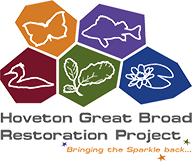Water Quality Monitoring
Science Officer Overview

Water quality monitoring
One of the first signs that restoration is working will be improvements in water quality, specifically a reduction in algae and turbidity, and clear water returning to Hoveton Great Broad and Hudson’s Bay.
Natural England has been carrying out monthly monitoring of water quality on Hoveton Great Broad and Hudson’s Bay since August 2014. The protocol for this monitoring was established in consultation with a team at University College London (UCL) who undertook some baseline sampling in 2014/15. The factors monitored were:
- Photosynthetically Active Radiation (PAR) – This is measurement of the fraction of sunlight usable by plants for photosynthesis (spectral range from 400 to 700 nm), providing a more meaningful measurement than water clarity (turbidity) alone.
- Reduction Oxidation Reaction (Redox) – Redox provides a measure of the level of potential chemical reactivity. It can be used in association with other measurements to understand how long pollutants may persist within waterbodies.
- Zooplankton – Small animals, like water fleas, from groups such as Cladocera, Copepoda, and Rotifera.
- Phytoplankton – algae, microscopic organism which photosynthesise.
- pH – A useful measure which can indicate pollution events and unwanted changes in water chemistry.
- Temperature – water temperature can have influence on algal growth and nutrient release from polluted sediment.
- Water clarity – Turbidity, measured using a secchi disk, provides a measure of the depth light can penetrate the water.
- Conductivity – is a measure of the number of ions within the water, it can be used to identify pollution or saline incursion events.
You can view the results of this monitoring in the phytoplankton and zooplankton report by UCL.
Water Quality monitoring has been continued by project staff on a monthly basis, continuing on from the work by UCL. This monitoring has included zooplankton, phytoplankton (June – September), water clarity, pH, temperature, and conductivity.
In addition, water samples have been taken monthly at two locations – one in Hoveton Great Broad and one in Hudson’s Bay. These samples were analysed by the Environment Agency, this analysis covers a suite of water quality measure, including:
- Chlorophyll a – a form of chlorophyll common in algae, this provides a measure of the number of algae within the water sample.
- Total Phosphorus (TP) – Phosphorus is normally natural limited in freshwater systems. Increased phosphorus is a key cause of high algal growth in freshwater habitats.
- Total Nitrogen (TN) –Nitrogen is another nutrient which can drive high algal growth.
Phosphorus and nitrogen are both nutrients required for algal growth. Key to maintaining a stable macrophyte community following biomanipulation is water quality, with sufficiently low levels of phosphorus (P) and nitrogen (N) maintained. Phosphorus levels of less than 0.055mg/l have been shown to be required to maintain stable recovery following biomanipulation. Whilst nitrogen concentrations of below 1-2 mg/l have been linked to higher macrophyte diversity, and in particular charophytes.
Nutrient stripping from the larger Sewage Treatment Works (STW) since the 1980s has significantly reduced the P concentrations in the River Bure which runs through Hoveton Great Broad. NE and EA continue to work with water companies and farmers to deliver further improvements in water quality. Modelling has shown that further planned nutrient stripping at STWs will reduce P levels to 0.052mg/l by 2030, but other interventions may see levels fall lower as we work towards a P target of 0.03mg/l. Recovery of aquatic plants in Hoveton Great Broad (which will stabilise sediment and absorb phosphorus) is also anticipated to reduce P and see TP levels lower than 0.055mg/l achieved within the 10 year lifespan of the biomanipulation. These reductions in phosphorus should see algal growth being P limited.
Total Nitrogen levels has previously received less attention although the broads are in a Nitrate Vulnerable Zone. The average nitrogen levels on Hoveton Great Broad are currently 2.94mg/l. We anticipate expect new nitrogen targets to be adopted (currently 1.5mg/l) and NE will be working with EA to tackle nitrogen levels through our work with water companies, farmers, and sustainable development.
The baseline water quality data we have gathered requires detailed analysis and how the different variables relate to each other is complex. Phosphorus release and phytoplankton growth both have seasonal trends, with increases in the spring and summer months. However, phosphorus release can also increase phytoplankton growth.

The graphs above indicate correlations between phytoplankton numbers (as indicated by chlorophyll a), water clarity (Secchi disk measurements), and phosphorus levels, beyond those explained only by seasonal temperature variance. The weaker correlation with Nitrogen indicates algal growth is currently linked to phosphorus and is not significantly N limited. Statistical analysis of this data will provide further insight into these correlations.
Water quality monitoring will continue following the biomanipulation of Hoveton Great Broad and Hudson’s Bay. Following restoration, we expect zooplankton numbers to increase and for larger species of zooplankton to be more abundant in the population. The increased zooplankton grazing will see phytoplankton numbers quickly decrease creating clear water. As water plant (macrophytes) establish we would expect the sediment to be stabilised with decreases in P release. We would also anticipate increase P and N absorption by these plants during spring/summer decreasing these nutrients further.
Our monthly water quality monitoring data is available on request, and the water samples analysed by the EA are available publicly on the EA’s water quality archive.
